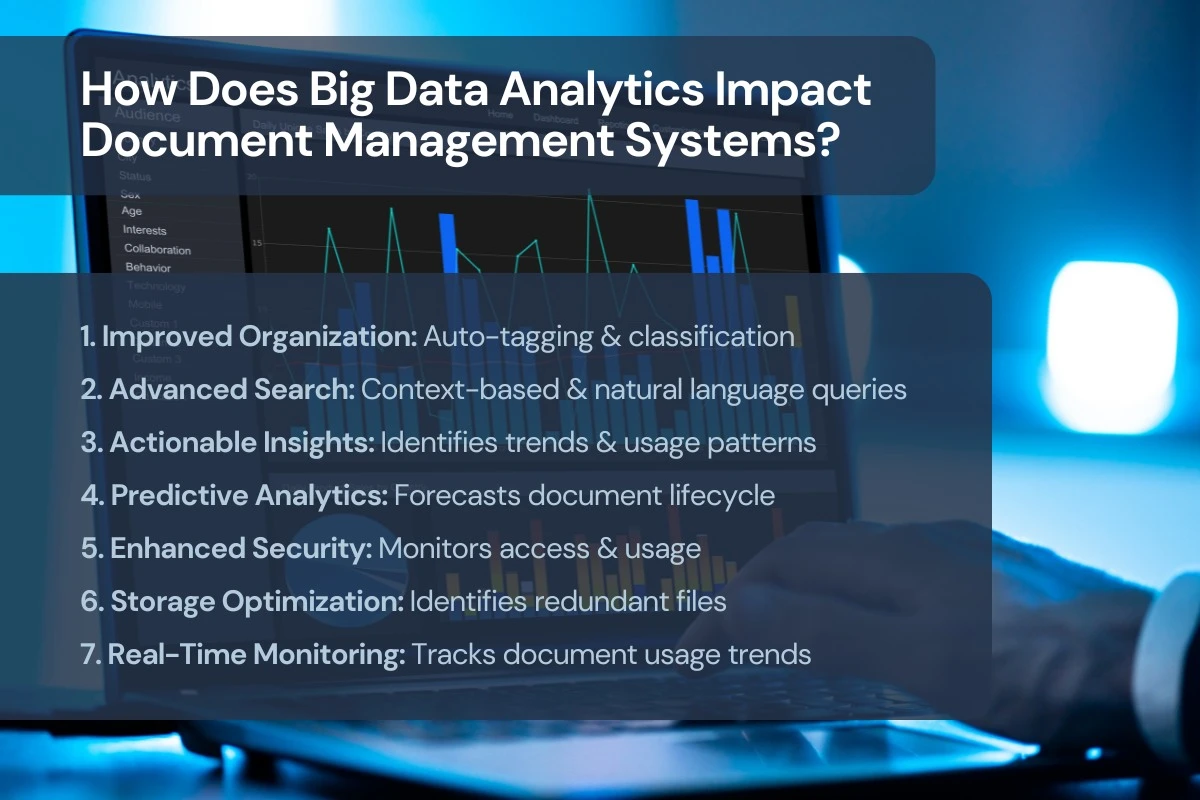How Does Big Data Analytics Impact Document Management Systems?

Businesses are always looking for ways to manage and benefit from massive amounts of data. The integration of Big Data Analytics in DMS has revolutionized document management in a way that businesses could organize, analyze, and utilize their documents much better. Let us see what role Big Data Analytics has taken in transforming the DMS.
1. Improved Document Management
Big Data Analytics enables the organization to structure and categorize unorganized data with ease. It can automatically classify and tag documents by analyzing metadata and content, ensuring they are stored in the right locations.
- 1.1 Example: Machine learning algorithms can analyze documents and assign keywords or tags, reducing manual intervention.
- 1.2 Impact: Better document organization leads to faster search, retrieval, and efficient workflows.1
2. Improved Search and Retrieval
Basic search functionality is what traditional DMS systems depend on. Through Big Data Analytics, the retrieval process of documents becomes faster as well as more accurate.
- 2.1 How it works: Analytics tools parse large data sets to seek out patterns and trends, thus enabling the advanced search facility such as natural language questions or context-based searches.
- 2.2 Outcome: Employees can identify critical documents instantly, reducing time spent and increasing productivity.
3. Actionable Insights
Big Data Analytics can analyze large document repositories to uncover actionable insights. Businesses can identify trends, monitor document usage, and understand how content is utilized across the organization.
- 3.1 Examples: Identifying frequently accessed documents, analyzing workflow bottlenecks, or recognizing redundant files.
- 3.2 Benefits: Businesses can optimize content strategies, reduce storage costs, and improve decision-making.
4. Predictive Analytics for Document Lifecycle Management
Managing a document’s lifecycle—from creation to archiving—is challenging, especially with large datasets. Predictive analytics uses historical data to forecast when documents are likely to become obsolete or require updates.
Advantage: Organizations can proactively manage document retention policies, reducing clutter and ensuring compliance.
5. Enhanced Security and Compliance
Data security and compliance are top priorities for businesses handling sensitive documents. Big Data Analytics helps identify anomalies and potential risks in document access or sharing.
- 5.1 How this works: Analytics tools monitor the use of documents, highlight suspicious patterns, and provide evidence of regulatory compliance.
- 5.2 Outcome: Enhanced document security, the risk of breaches is lower, and compliance audits are easy to perform.
6. Optimized Storage and Resource Management
A high volume of documents leads to cost and inefficiency in storing them. Big Data Analytics optimizes storage resources by identifying redundant, outdated, or unused files.
Impact: Businesses can cut the cost of storage, increase performance, and only maintain relevant documents.
7. Improved Collaboration and Workflow Efficiency
Big Data Analytics streamlines the workflow through insights into tasks and processes involving documents. Delays can be detected and improved team collaboration made, as well as automatic document routing through analytics-driven decisions.
- 7.1 Example: Identifying bottlenecks in approval workflows and suggesting process improvements.
- 7.2 This results in enhanced team collaboration and faster project completion.

8. Real-Time Monitoring and Reporting
Organizations can use Big Data Analytics to track document management operations in real-time. It will also give detailed reports about document access, modification, and usage trends.
Managers will be in better control of document-related processes, with the responsibility and transparency being addressed.
9. Supporting AI-Driven Automation
Big Data Analytics collaborates with AI to support intelligent automation of DMS. This includes automated document sorting, data extraction, and content summarization.
- 9.1 How It Works: Analytics identifies patterns and trains AI algorithms to perform repetitive tasks accurately.
- 9.2 Result: Companies increase operational efficiency, cut down on errors, and save time.
10. Scalability for Growing Businesses
The quantity of documents increases with the size of businesses. Big Data Analytics guarantees that DMS will scale large datasets without affecting performance.
Advantage: Businesses will maintain efficiency and organization no matter how large their document repository grows.
11. Conclusion
It is with such changes that Big Data Analytics was incorporated into Document Management Systems to allow companies to manage volumes that grow daily. While offering accurate search results and organization of the document, analytics enables firms to make decisions on-time while optimizing their workflow; however, this depends on embracing digital transformation as time progresses.
MillionDox integrates accurate data into company processes to deliver sophisticated document management solutions. As a result, procedures become more data-driven, safe, and effective.
8
12. FAQ
- 12.1 How does Big Data Analytics help in file organization?
Big Data Analytics automatically categorizes and labels files with content and metadata analysis that enables efficient file organization, storage, and retrieval. - 12.2 How does predictive analytics assist in document management?
Predictive analytics enables one to predict the lifecycle of a document; thus, it helps one to identify when they may become obsolete or have to be updated to ensure non-cluttered storage and compliance. - 12.3 Do Big Data Analytics help search for more accuracy in DMS?
Yes, Big Data Analytics helps users find documents rapidly and accurately with options such as natural language processing and contextual search. - 12.4 Does Big Data Analytics make it easier to secure the documents?
Yes, Big Data Analytics detects anomalies and suspicious access or sharing of documents; thus, it will avoid compliance risks and the potential to breach data. - 12.5 How does Big Data Analytics optimize storage?
It identifies redundant, outdated, or unused files, which can help businesses save on storage costs and enhance resource management. - 12.6 How does Big Data Analytics optimize storage?
It identifies redundant, outdated, or unused files, which can help businesses save on storage costs and enhance resource management. - 12.7 Does Big Data Analytics support very large document repositories?
Yes, it supports scalability in the case of growing businesses, where large datasets are efficiently processed without sacrificing performance. - 12.8 What business insights does Big Data Analytics offer?
It helps in identifying trends and workflow bottlenecks along with document usage patterns for better decision-making and process optimization for businesses.
To know more about this visit MillionDox.com